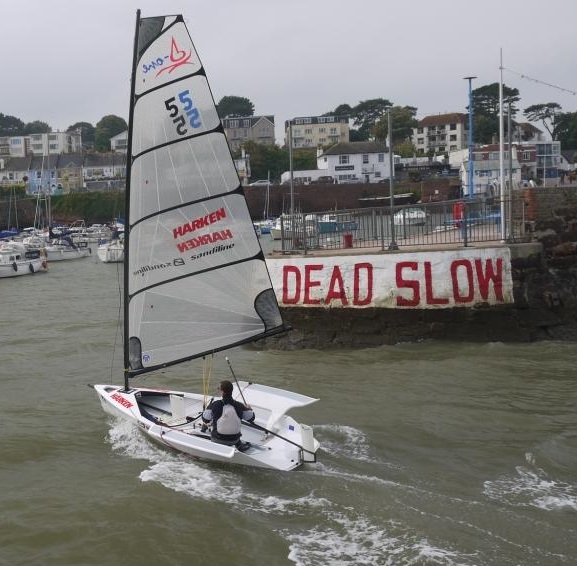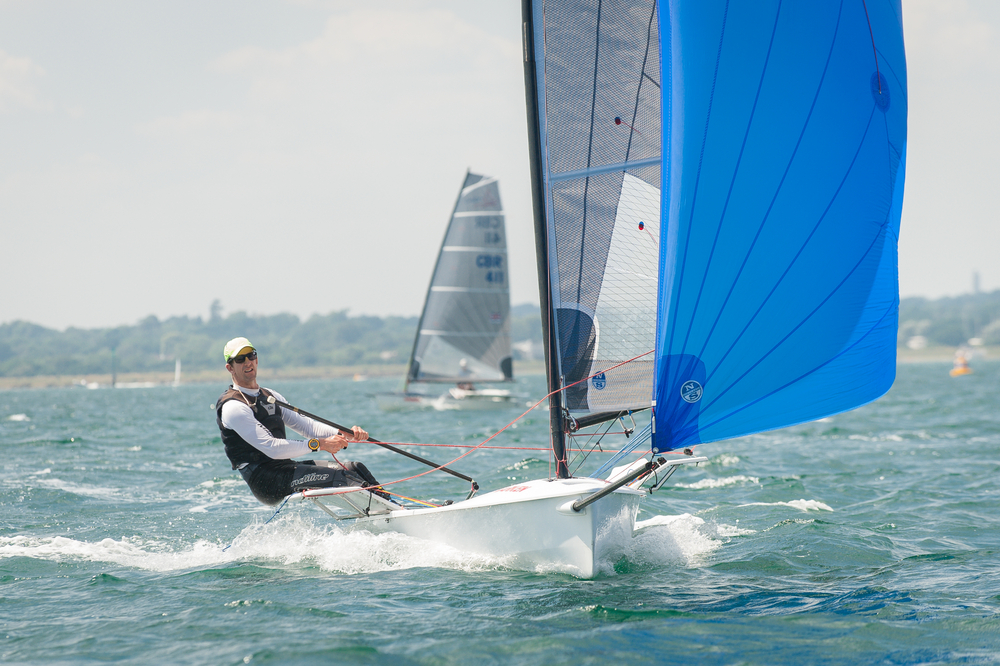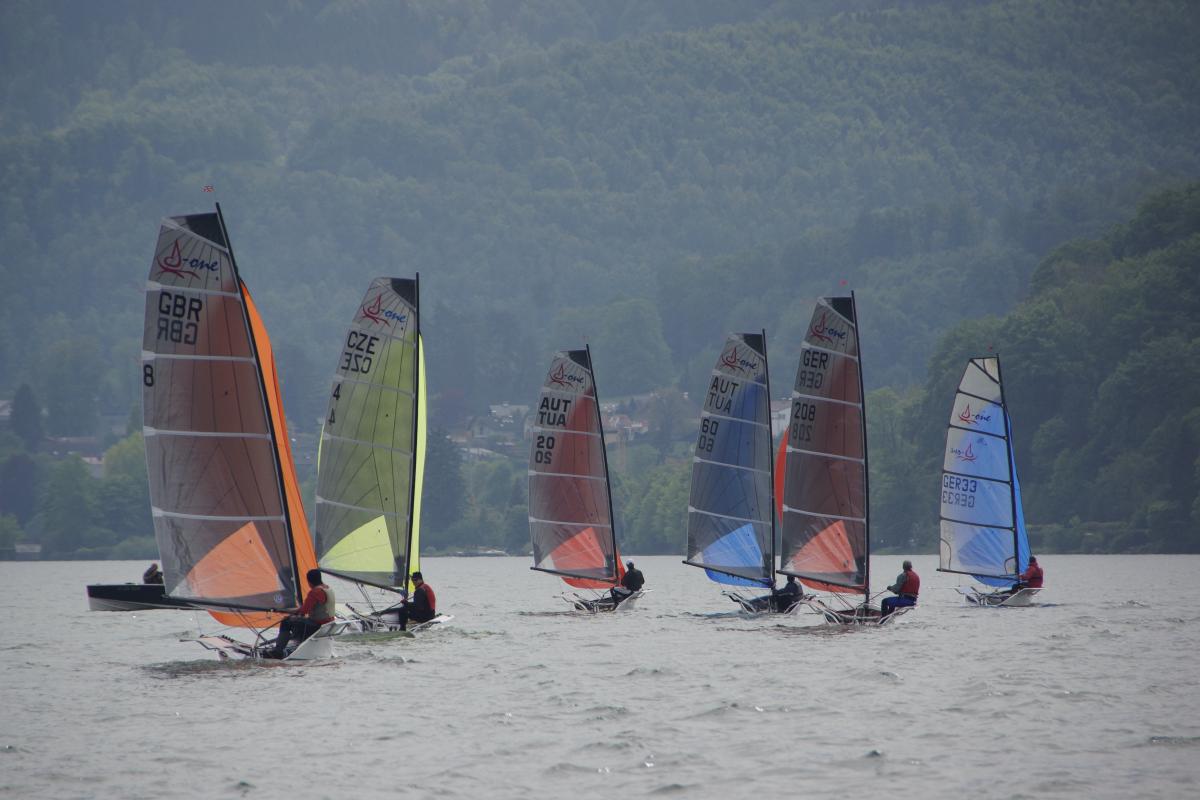Mast rake
There is surprisingly little variation in mast rake in the fleet with most set on 6m74 as the best all round setting. This is measured with the main halyard in the lock and a tape measure run to the transom.
Raking back in breeze helps depower but the boom soon hits the deck so raking further means you can’t get enough leech tension. So I rake to 6m72 when it is windy. Windy is when you are consistently overpowered. In terms of wind strength that will vary according to your weight, wing setting and hiking. I am raking back in around 18knots+
Raking forward helps power up but raking too far moves the centre of lateral resistance too far forward so you no longer generating sufficient lift off the foils. I rake up to 6m76 when I am consistently underpowered i.e. not fully hiked. I have tried raking up further but it doesn’t feel right to me but some are making 6m80 work, worth a try. I rake forward below about 8 knots.
Upwind
 Mainsheet tension
Mainsheet tension
The D1 likes a lot of mainsheet tension. Most upwind sail adjustment is through the traveller but the main should be adjusted for significant variations in wind speed. The mast is quite bendy so there is a significant amount of luff curve in the sail to match the mast bend. This makes setting the main in light winds challenging. If you set the main for the leech to look nice, the mast will straighten and all that luff curve will result in a very full luff entry resulting in the wind stalling before it can flow over your sail. So you need to compromise and stall the leech slightly and intermittently to suck some of the fullness out of the luff. Up the wind range, the main likes takes quite a lot of tension, ending up boom to deck in big winds
In a stable breeze, the main may be barely adjusted upwind. In variable wind, the main might be adjusted every 30 seconds but rarely more than this because focus should be on trav. adjustment. You are looking for the upper leech of the main to be on the edge of hooking. I don’t use the leech tell tales as they tend to only break when you are well over-sheeted so are insufficiently sensitive. Time in the boat is the best way to generate a feel for correct mainsheet tension and ideally 2 boat tuning. Tuning gives an idea of when you are over-sheeted so you point high but lose speed and the boat feels a bit dead. Under-sheeted and you will lack height which is so key in any boat which doesn’t plane upwind.
Traveller
I have marks on the traveller every 10cmm from the centre line
In light winds, I usually sail with the traveller 1 mark away from the centre line. Centralising the trav. can be really fast but it a very narrow and temperamental groove. You are asking the wind to bend a long way round the sail so it is unsurprising this setting is tricky!
The D-1 is very sensitive to traveller settings so it should be adjusted a lot, especially in gusty and shifty conditions. If you feel consistently over-powered and can’t sail flat, drop traveller. As soon as you can ease up on hiking, pull traveller up to keep power and height. Pulling the traveller higher in lulls is a great way to gain height without having to pinch, though it does mean limited hiking rests!
The traveller allows you to sail the D1 at a wide range of angles upwind without much loss of VMG in moderate/windy weather. In light winds, dropping traveller loses height with little speed gain so is useful if you overlay a mark or sometimes tactically. In moderate/windy weather, the traveller comes into its own as whilst there is a best setting for maximum VMG, the VMG loss is not big for dropping well below this ideal setting or slightly above. This gives you a range of angles to play with. You can potentially shift towards shifts/pressure faster without tacking, escape or create dirty wind, adjust your positioning vs. the fleet etc.
Kicker
None needed as leech tension is applied via the main. I will leave my downwind kicker setting in place upwind so giving 1 less adjustment to make, less distraction. Having some kicker tension helps when you ease the main on tacks to keep power in the sail. In very light winds, kicker can work better than mainsheet to bend the mast and suck fullness out the luff and flatten the sail. I haven’t made this work consistently; it is very easy to stall the sail with kicker in light winds
Outhaul
The outhaul controls fullness in the lower 1/3 of the sail and lower leech shape. In very light winds the wind has little energy so won’t make it round big curves. So I don’t ease too much outhaul or the sail becomes full and the wind will break off the sail early. In moderate winds, I will ease the most outhaul to generate more power and enable early hiking. In bigger breeze, the outhaul is tightened to depower. Easing outhaul also tightens the lower leech so I will use the least outhaul in flat water and tighten more in chop
Inhaul
This controls the draft in the lower 1/3 of your sail. More inhaul pulls fullness forward which is good if you want to point lower e.g. in chop. In light winds, there is little energy in the wind so it won’t make it round big curves. So in light winds, use less inhaul to flatten the luff entry and enable air flow to attach to your sail for longer. When it is windier, wind will stay attached for longer around curves so draft naturally moves aft in your sail. So you should use more inhaul to compensate for this to maintain a nice aerofoil. On a D1, the inhaul isn’t adjustable whilst racing but you can adjust your tie-off position onshore or in between races.
Cunningham
With a very powerful rig, cunningham is your friend in a D1! Cunningham bends the mast and opens the upper leech so results in a loss of height but reducing power so making the D1 both more manageable and faster in windy weather. Cunningham is your best friend when it is really windy as pulling it hard bends the top of mast and loses power high up where there is most heeling moment. As cunningham results in a loss of height, I will reach for it earlier in chop to the boat naturally tracks lower so working through waves more easily. I will reach for it later on a lake where height is good with no waves to slow you down.
Centreboard
I sail with the centreboard down in all conditions. I’ve tried bringing up a little in breeze to reduce drag but not really made it work, probably because we don’t plane upwind
Toestraps
Perhaps surprising to see this on a tuning guide. I think adjustable toestraps are really important on a hiking boat. Having very tight toestraps in light winds enables you to lock your feet under the straps so feel the boat early. The ideal base hiking position, though more painful, is pretty straight legs with an upright upper body. That gives you the most gust response as you can quickly move from upright upper body to flat hiking. If you are hunched, your gust response is more limited and it takes longer to move in when there is a lull. Tight toestraps enable straight leg hiking and an upright upper body in light winds
I then ease the toestraps as the wind increases and have a knot in my toestrap rope at the maximum hiking position so I know where max. hiking is to both stop me being lazy by not easing them enough or having the rope slip and falling out the boat!
This is a technique rather than tuning thought but the D1 loves being sailed dead flat upwind, like most boats.
Downwind
 Centreboard
Centreboard
I lift the centreboard sometimes in light winds to soak lower for longer on a gust, especially when the wind is patchy. I think the VMG is probably slightly worse with the board up but this gives another possible angle and tactical option downwind.
Kicker
The kicker should be set so your upper leech just opening and closing. If the leech is always open, use a little more kicker. If the leech is always closed so static, use a little less kicker.
Outhaul
I ease outhaul downwind, probably around 1-1½ hand widths
Cunningham
The cunningham should be fully eased downwind to straighten your mast and give maximum power. Ease the cunny before the windward mark or you risk damaging your sail as you bear off. You might use cunningham on a windy tight reach to dump power so you can sail flat and flap the main/kite less – flogging sails are a lot of drag.
Mainsheet
Your focus downwind should be on the spinnaker so the main should only be adjusted for major changes in angles. In light winds, it pays to soak low. In marginal planning, the 1st boat to heat up and plane will be fastest. But being 1st is high risk because if you don’t plane you simply sail more distance. In breeze, the D1 has a high plane mode requiring some hiking and a low plane mode where you can perch on the side. Both have similar VMG. Low plane mode is useful for giving the legs a rest before the next beat. As you switch between all these modes, you will need to make mainsheet adjustments. In a steady wind, you might cleat the mainsheet for the whole run. In gusty conditions, you might make 5-10 adjustments on a run
As a rough guide, I set the main so it is parallel with the leech of the spinnaker with the main luff tell tales flowing nicely
The D1 is very sensitive to for-aft trim to remember to move for-aft as well as sideways during transition between these modes and wind strengths.
Steering
With a lot of steering, you should ideally use body movement to steer rather than dragging your rudder around. Body movement to steer is legitimate and constitutes good sailing under rule 42. However, each jury interprets this highly subjective area differently so be aware that the interpretation of what body movements are legal in different conditions is changeable from week to week.
Summary
The D1 has many gears and is highly responsive so is a joy to sail and rewards time in the boat to understand her.


 https://www.centroveladervio.it/
https://www.centroveladervio.it/ Royal Western Yacht Club
Royal Western Yacht Club